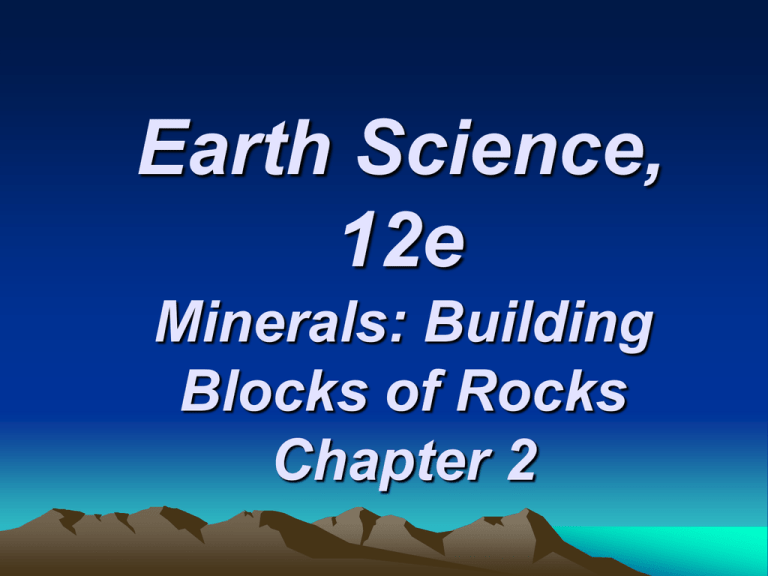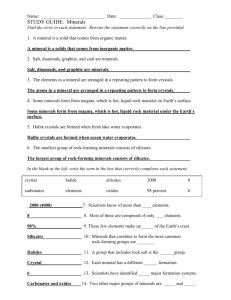Volcanoes and Igneous Activity Earth
advertisement

Earth Science, 12e Minerals: Building Blocks of Rocks Chapter 2 Minerals: the building blocks of rocks Definition of a mineral • • • • • Natural Inorganic Solid Possess an orderly internal structure of atoms Have a definite chemical composition Mineraloid – lacks an orderly internal structure Composition and structure of minerals Elements • Basic building blocks of minerals • Over 100 are known Atoms • Smallest particles of matter • Have all the characteristics of an element Periodic Table of the Elements Figure 2.4 How atoms are constructed Nucleus – central part of an atom that contains • Protons – positive electrical charges • Neutrons – neutral electrical charges Energy levels, or shells • Surround nucleus • Contain electrons – negative electrical charges Simplified view of the atom Figure 2.5 How atoms are constructed Atomic number is the number of protons in an atom’s nucleus Bonding of atoms • Forms a compound with two or more elements • Ions are atoms that gain or lose electrons Isotopes • Have varying number of neutrons How atoms are constructed Isotopes • Have different mass numbers – the sum of the neutrons plus protons • Many isotopes are radioactive and emit energy and particles Minerals Physical properties of minerals • • • • • • Habit Luster Color Streak Hardness Cleavage The mineral quartz often exhibits good crystal shape Figure 2.21 Pyrite (fool’s gold) displays metallic luster Figure 2.11 Mohs scale of hardness Figure 2.13 Three examples of cleavage – halite, calcite, and fluorite Figure 2.15 B Minerals Physical properties of minerals • Fracture • Specific gravity • Other properties • • • • Taste Smell Elasticity Malleability Conchoidal fracture Figure 2.16 Minerals Physical properties of minerals • Other properties • • • • Feel Magnetism Double refraction Reaction to hydrochloric acid Minerals A few dozen minerals are called the rockforming minerals • The eight elements that compose most rockforming minerals are oxygen (O), silicon (Si), aluminum (Al), iron (Fe), calcium (Ca), sodium (Na), potassium (K), and magnesium (Mg) • Most abundant atoms in Earth’s crust are oxygen (46.6% by weight) and silicon (27.7% by weight) Composition of continental crust Figure 2.19 Minerals Mineral groups • Rock-forming silicates • Most common mineral group • Contain the silicon-oxygen tetrahedron (molecule) • Four oxygen atoms surrounding a much smaller silicon atom • Combines with other atoms to form the various silicate structures The silicate (SiO4 molecule Figure 2.20 4– ) Minerals Mineral groups • Rock-forming silicates • Groups based on tetrahedral arrangement • Olivine – independent tetrahedra • Pyroxene group – tetrahedra are arranged in chains • Amphibole group – tetrahedra are arranged in double chains Hornblende – a member of the amphibole group Figure 2.21 Minerals Mineral groups • Rock-forming silicates • Groups based on tetrahedral arrangement • Micas – tetrahedra are arranged in sheets • Two types of mica are biotite (dark) and muscovite (light) • Feldspars – Three-dimensional network of tetrahedra Minerals Mineral groups • Rock-forming silicates • Groups based on tetrahedral arrangement • Feldspars • Two types of feldspar are Orthoclase and Plagioclase • Quartz – three-dimensional network of tetrahedra Potassium feldspar Figure 2.21 Minerals Mineral groups • Rock-forming silicates • Feldspars are the most plentiful mineral group • Crystallize from molten material • Nonsilicate minerals • Major groups • Oxides • Sulfides Minerals Mineral groups • Nonsilicate minerals • Major groups • Sulfates • Carbonates • “Native” elements Common nonsilicate mineral groups Table 2.1 Minerals Mineral groups • Nonsilicate minerals • Carbonates • A major rock-forming group • Found in the rocks limestone and marble • Halite and gypsum are found in sedimentary rocks • Many have economic value Minerals Mineral resources • Reserves are already identified deposits • Ores are useful metallic minerals that can be mined at a profit • Economic factors may change and influence a resource An underground halite (salt) mine Figure 2.22







